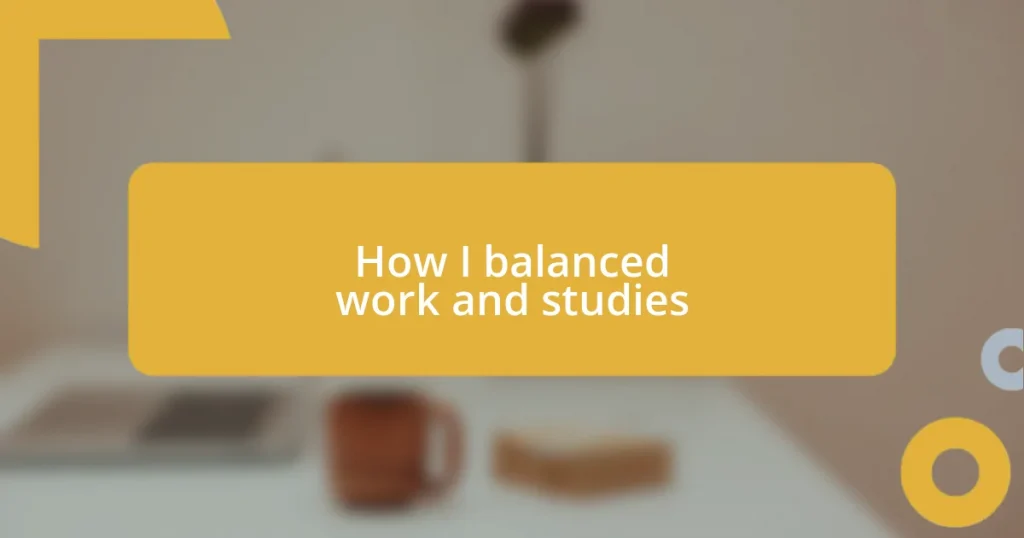Key takeaways:
- Prioritizing tasks and setting boundaries helped improve productivity and reduce anxiety, allowing for focused work sessions.
- Utilizing tools like Todoist, the Pomodoro Technique, and digital calendars facilitated better organization and task management.
- Establishing a supportive network and implementing self-care practices were essential for emotional well-being and maintaining balance during busy times.

Setting clear priorities for success
One of the most transformative decisions I made was to list my priorities each week. By doing this, I could visually see what needed my immediate attention versus what could wait. Have you ever felt overwhelmed by your to-do list? I certainly have, but breaking things down into manageable chunks relieved that pressure and clarified my focus.
When I started prioritizing tasks, I noticed a real shift in my productivity. Instead of jumping from one task to another, I dedicated specific blocks of time to subjects or projects. This focused approach not only made me more efficient but also reduced the anxiety that came from feeling like I was constantly multitasking.
Setting clear priorities also meant learning to say no to distractions. Early on, I realized that my friends’ spontaneous plans often clashed with my study schedule. One evening, I turned down a last-minute outing and instead reviewed for an important exam. It felt tough, but that choice ultimately led to better grades and less guilt. Isn’t it a powerful feeling to see your commitment pay off?

Utilizing productivity tools and techniques
Utilizing productivity tools and techniques can genuinely elevate the way we manage both work and studies. I found that using apps like Todoist helped me keep track of my tasks in a more visual way. Watching my tasks get checked off was oddly satisfying and gave me a sense of accomplishment each day, reminding me of the progress I was making.
Another technique that worked wonders for me was the Pomodoro Technique—this involves working in focused bursts of 25 minutes, followed by a five-minute break. Initially, I was skeptical about how effective a timer could be, but I quickly discovered that it transformed my work sessions. Those short breaks not only kept my mind fresh but also kept me motivated, as I was always looking forward to the next quick pause.
I also embraced digital calendars, which allowed me to schedule my studying around my work commitments. The best part? I color-coded events to easily distinguish between study time, meetings, and personal time. I remember one particularly stressful week where I was juggling multiple assignments and work tasks, but with my calendar neatly organized, it felt like I had a handle on my chaos. Isn’t it a relief when you can see your plan laid out in front of you, turning what used to be overwhelming into something manageable?
| Productivity Tool | Description |
|---|---|
| Todoist | A task management app that helps prioritize and visualize tasks. |
| Pomodoro Technique | A time management method that combines work sessions with short breaks. |
| Digital Calendar | An organizational tool for scheduling tasks, events, and deadlines. |

Establishing a supportive network
Building a supportive network was crucial for me in balancing work and studies. I quickly realized that my friends, family, and colleagues could provide not just encouragement, but also practical help when things got overwhelming. One evening, when I felt completely drained after a long week of work and study, I reached out to a close friend and shared my struggles. To my surprise, she offered to help me with some study materials while we caught up over coffee. That simple gesture not only lightened my workload but also reminded me of the importance of leaning on others during tough times.
Here are some ways I found that a supportive network can aid in managing responsibilities:
- Sharing Resources: Engage with peers who can share study materials or insights on tricky subjects.
- Motivational Check-ins: Regular catch-ups with friends can provide moral support and accountability.
- Time Management Tips: Collaborating with others often leads to discovering new strategies for managing workload.
- Emotional Support: Venting frustrations to trusted individuals can ease stress and foster resilience.
- Group Study Sessions: Teaming up with others for study sessions can make learning more enjoyable and productive.
Creating this network was not just beneficial; it became a vital part of my journey, reminding me that I wasn’t alone in facing these challenges. Having a solid support system has been one of the best decisions I made during this busy phase of my life.

Implementing self-care practices
Implementing self-care practices was a game changer in my balancing act between work and studies. I remember one particularly hectic stretch where I felt like I was constantly running on empty. That’s when I decided to carve out a few moments each day just for myself—whether it was enjoying a hot cup of tea in the morning or indulging in a short walk during lunch breaks. These little acts of self-kindness reminded me that my well-being was a priority, and they rejuvenated my spirit to tackle the next task.
One self-care practice that I found incredibly grounding was meditation. At first, I was skeptical—how could sitting still for a few minutes help my chaotic mind? But once I committed to a daily five-minute practice, I noticed a shift. Those quiet moments offered me clarity amidst the whirlwind of deadlines and responsibilities. It was almost as if I was giving my brain a chance to reset. Have you ever noticed how just a little pause can change your whole perspective? I certainly did.
Moreover, I made a point to nurture my hobbies—something that often gets sidelined during busy times. For me, that meant diving back into reading fiction now and then. It’s amazing how losing yourself in a different world for even a short time can lift your spirits. I found that these small bursts of joy not only brought balance to my days but also sparked my creativity, helping me approach my studies and work with a refreshed mindset. Self-care isn’t just a trendy buzzword; it’s a necessary pillar for thriving, especially when juggling multiple commitments.

Reflecting on progress and adjustments
Reflecting on my progress throughout this balancing act was an eye-opening experience. There were moments when I felt overwhelmed, as if the weight of my commitments might crush me. I vividly remember one late-night study session where I just froze—surrounded by notes, questioning if I was even making real progress. That night, I realized I needed to pause and reflect. Giving myself the space to assess what was working and what wasn’t helped me regain my focus and adapt my strategies.
Adjustments became a routine part of my journey. Once, after beating my head against the wall trying to juggle a demanding project at work with exam prep, I took a step back. I had to rethink my approach—was my studying method actually effective? So, I tried breaking down tasks into smaller chunks and rewarded myself after completing each one. This not only kept me motivated but also revealed that, although sometimes sticky, progress is often about those small wins, don’t you think?
As time went on, my reflections highlighted the importance of flexibility. I used to think it was all about sticking to a rigid schedule, but I learned that life has its own rhythm. There was a week when unexpected work demands came up, and my initial reaction was panic. However, I reevaluated my priorities and shifted my study sessions to fit the new timeline. Embracing those adjustments was crucial. It taught me that resilience is less about never falling behind and more about how quickly I can adapt and bounce back.















